Jan van der Venne
Peasants preparing a Meal in a Landscape
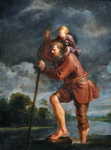
St Christopher Carrying the Christ Child
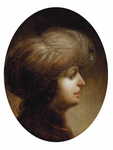
Portrait of a gentleman, bust-length in profile, in a red coat and white turban
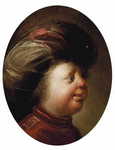
Portrait of a gentleman, bust-length, in a red coat and turban
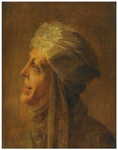
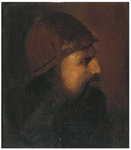
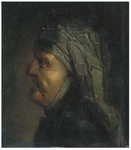
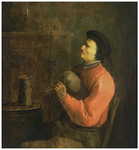


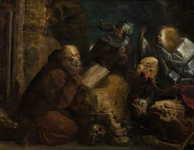
The Temptation of Saint Anthony
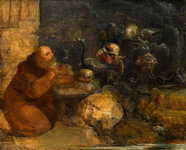
The Temptation of Saint Anthony
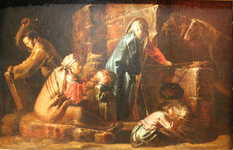
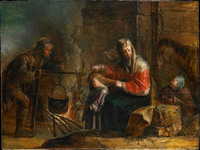
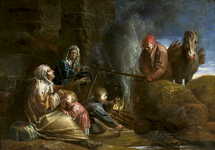
Jan van de Venne or Jan van der Venne, also known as Pseudo van de Venne[1] (active by 1616 – died before 1651), was a Flemish painter of genre, religious scenes, and cabinets who was court painter to the governors of the Southern Netherlands.[2] Many of his works depict "low-life" genre scenes of tooth-pullers, card-players and hurdy-gurdy players, tronies and expressive religious scenes.[3]
Rediscovery and identification
Works by Jan van de Venne were formerly attributed to an artist referred to as ‘Pseudo-Van de Venne’. This Pseudo-Van de Venne was erroneously believed to be the brother, also called Jan, of the better known Dutch painter Adriaen van de Venne.[4] Adriaen's brother Jan, however, died in Middelburg in 1625.[5]
The fortune teller
Art historian Jacques Foucart from the Louvre corrected the wrong attribution in an article published in 1978. Foucart identified Pseudo-Van de Venne with another Jan van de Venne whom he identified as a Flemish artist.[6] This identification of ‘Pseudo-Van de Venne’ with Jan van de Venne, an artist believed to have been born in Mechelen c. 1600, has since gained wide acceptance.[3]
Life
Very little is known about Jan van de Venne's life and career. Even though some of the artist’s works bear the mark of the Antwerp Guild of Saint Luke, he is believed to have been active mainly in Brussels. This is testified by his relationships with prominent personalities in Brussels including at the court.[6] Both Cardinal-infant Ferdinand and Archduke Leopold Wilhelm, the governors of the Southern Netherlands, were his patrons. Van de Venne is recorded as a master in the Guild of Saint Luke in Brussels in 1616.[4]
He is believed to have been active as a painter as well as a gilder of moldings and perhaps even a painter of imitation marble on frames and altarpieces.[6] He remained active in Brussels where he died in or before 1651.[7]
Work
General
A fight in an inn
Van de Venne left very few signed paintings. His oeuvre has been reconstituted based on signed or documented works which show his very individual style, subjects, use of light and brilliancy.[4] His works are typically small-scale oil on panel compositions.
Van de Venne specialised in caricatures of so-called ‘low-life’ subjects, such as card-players, tooth-pullers and musicians, and in expressive religious scenes.[4] His paintings demonstrate harsh caricatures in a stronger light than Adriaen Brouwer.[3]
Influences
Various historians have attempted to explain the origins of his style. They have identified a range of influences on the work of van de Venne: his themes and style are reminiscent of his contemporary Adriaen Brouwer.[3] His preference for brownish tonalities and themes are similar to those of Dutch such as Adriaen van Ostade, Benjamin Cuyp and Andries Both. His nervous style shows possibly the influence of David Teniers the Elder and some authors even conjecture he may have studied under Teniers.[4] Lucas van Leyden's engravings as well Adam Elsheimer’s treatment of the effects of light and shade are also cited as possible influences. Some of his works have formerly been attributed to the style of Rembrandt.[2]
Jan van de Venne is believed to have in turn exerted an influence on other contemporary artists. For instance the Dutch Bambocciante painter Andries Both is believed to have derived his propensity for caricature-like distortions of the faces and poses of his figures from the compositions of van de Venne.[8]
Tronies
Many of his works are caricatural portraits of heads. The squeaky misery of the characters he depicts often in profile and the virtuosity of the pasty effects come close to the early production of Georges de la Tour. The use of light that make the clothes and folds flicker also evokes the last French Mannerists such as Claude Vignon or Claude Deruet.[9]
Gypsy scenes
Gypsy family
Jan van de Venne regularly painted scenes with gypsies. As many of these works with gypsies are in collections in French museums (Aix-en Provence, Auxerre, Besançon, Chambéry, Dijon, Dunkirk, Hazebrouck, Lille, Marseille, Louvre, Quimper and Semur-en-Auxois) he earned the sobriquet ‘le Maître des Tziganes’ (the Master of the Gypsies) in France.[4]
An example of one his gypsy scenes is the Gypsy family at the Musée des Beaux-Arts et d'archéologie de Besançon, which shows a gypsy family preparing an outdoor meal over a fire while a woman is delousing a child.
The Temptation of St Antony
He also painted various versions of The Temptation of St Antony. This subject was very popular in Flemish art from the late 15th century. Catholics regard Saint Anthony as a model to be emulated as he is believed to have resisted multiple temptations sent to him by the devil. Flemish paintings dealing with the theme of the temptation of Saint Anthony are typically populated with witches and monstrous creatures that tempt him. Van der Venne's versions of The Temptation of St Antony with different compositions are in museums in Dunkerque, Haarlem and Holbourne and one was sold at Auktionshaus im Kinsky on 28 November 2013 in Vienna (as lot 2).
The version sold at Auktionshaus im Kinsky shows St Anthony in a cave kneeling in front of a table with books. To his right appear fanciful phantoms and in the background a witch with a young woman.[10]
References
Music-making beggars
Ancient sources sometimes spell his name as ‘van der Vinnen’
The Temptation of St Antony at the National Inventory of Continental European Paintings
Hans Vlieghe (1998). Flemish Art and Architecture, 1585–1700. Pelican History of Art. New Haven: Yale University Press, p. 159. ISBN 0-300-07038-1
About Jan van de Venne at Jean Moust Old Master Paintings
Martin Royalton-Kisch. "Venne, Adriaen van de." Grove Art Online. Oxford Art Online. Oxford University Press. Web. 20 March 2015
Jan van de Venne, dit le Pseudo van de Venne, in: Vente de prestige - Tableaux Anciens et du XIXe siècle – Tajan, 20 June 2007, p. 16 (French)
Jan van der Venne at the Netherlands Institute for Art History (Dutch)
Ludovica Trezzani, "Andries Both," Grove Art Online. Oxford University Press. Web. 20 March 2015
Jan van de Venne, 'Tronies : Tête de soldat en armure; et Tête de femme agée at Christie's (French)
Jan van der Venne, genannt Pseudo van der Venne, Die Versuchung des Hl. Antonius at Auktionshaus im Kinsky (German)
Further reading
J. Foucart, 'Une fausse énigme: le pseudo et le véritable van de Venne' in Revue de l'Art, 1978, p. 53-62
----
Fine Art Prints | Greeting Cards | Phone Cases | Lifestyle | Face Masks | Men's , Women' Apparel | Home Decor | jigsaw puzzles | Notebooks | Tapestries | ...
----
Artist
A - B - C - D - E - F - G - H - I - J - K - L - M -
N - O - P - Q - R - S - T - U - V - W - X - Y - Z
Retrieved from "http://en.wikipedia.org/"
All text is available under the terms of the GNU Free Documentation License



